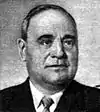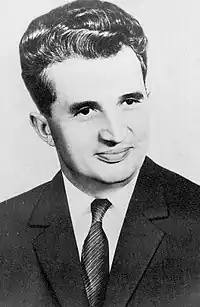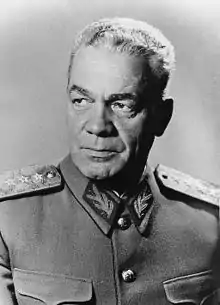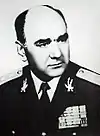Army of the Socialist Republic of Romania
The Army of the Socialist Republic of Romania (Romanian: Armata Republicii Socialiste România), known as the Army of the Romanian People's Republic (Romanian: Armata Republicii Populare Romîne), until 1965 was the army of the Socialist Republic of Romania (Romanian People's Republic until 1965) from 1947 to 1989. Following the Romanian Revolution in 1989 it was renamed into the Romanian Armed Forces. It consisted of the Ground Forces, the Navy and the Air Force.
| Army of the Romanian People's Republic (1948-1965) Army of the Socialist Republic of Romania (1965-1989) | |
|---|---|
| Armata Republicii Populare Romîne (1948-1965) Armata Republicii Socialiste România (1965-1989) | |
.svg.png.webp) Ceremonial Flag (1966-1989) | |
| Motto | Pentru Patria Noastră ("For our Homeland") |
| Founded | 1947 |
| Disbanded | 1989 |
| Service branches |
|
| Headquarters | Bucharest |
| Leadership | |
| Supreme Commander-in-chief | Nicolae Ceaușescu (as President) from 1974 |
| Minister of Defence | Army General Emil Bodnăraș (first) Colonel General Vasile Milea (last) |
| Chief of the Romanian General Staff | Colonel Constantin Popescu (first) Colonel General Ștefan Gușă (last) |
| Manpower | |
| Conscription | Yes |
| Active personnel | 210,000 |
| Industry | |
| Foreign suppliers | |
| Related articles | |
| History | |
History
.jpg.webp)

In 1944 the Red Army invaded Romania in the Jassy-Kishinev Offensive, causing the overthrow of Ion Antonescu's regime via a coup. In 1945, new military regulations were developed based on those of the Red Army[1] and in 1946, Romania came completely under the influence of the Soviet Union and became part of the Eastern Bloc. The military regulations were finalized in 1949. Like all other socialist states, the Army was subjected to the rule of the Romanian Communist Party, whose general secretary was, since 1974, President of the Republic in addition to his role as commander-in-chief of the army.
During the tenure of General Emil Bodnăraș as defence minister, the Army went through a period of Sovietization, with Bodnăraș personally sending several Romanian Communists to Moscow to be trained in Soviet military institutions such as the Frunze Military Academy.[2][3] 30% of the experienced officers corps were purged from the military due to fears of opposition and monarchist loyalties.[4] Between 1949 and 1952, over 700 Romanian military personnel were being trained in the USSR, a number that would drop by over 200 by in the next 6 years.[5] They also adopted a Soviet-style full dress uniform and everyday uniform. In the early days of the Republic, the Soviet Armed Forces had troops stationed in the country. The Soviet presence came as a result of the Soviet occupation of Romania. Bodnăraș was seen to have influence in Nikita Khrushchev's decision to withdraw Soviet troops in 1958.[6][7][8]
From May 1955 to 1991, Romania was a member of the Warsaw Pact, which provided the Romanian Army with weapons and other Soviet-made equipment, as well as assistance in building up its own defense industry.[9] Under the presidency of Nicolae Ceaușescu, the RPA asserted functional independence in the defense industry and on equipment acquisitions while maintaining strong ties to the Warsaw Pact Command, with many of its armored vehicles, aircraft and artillery, as well as individual weaponry, being nationally produced. Also, a new set of enlisted and NCO ranks were adopted in the 1970s, alongside the reinstatement of the senior NCO ranks (maistru militar), which replaced the former Soviet rank model for such personnel. On 12 March 1958, the Sports Committee of Friendly Armies was created, with the Romanian Army became a founding member. In November 1986, a referendum was held by the government in which voters, when asked whether they approved of reducing the size of the army and cutting military spending by 5%, approved the proposals by 100%, with not a single vote counting against it.[10] The Armed Forces would be renamed in 1989 following the Romanian Revolution, during which officers and personnel of the military defected to the side of the opposition after a public speech by Ceaușescu broadcast on state television[11] and a firing squad provided by paratroop regiment personnel Captain Ionel Boeru, Sergeant-Major Georghin Octavian and Dorin-Marian Cîrlan took part in the Trial and execution of Nicolae and Elena Ceaușescu on 26 December.[12]
Political and military leadership
Supreme Commander-in-Chief
The title of Supreme Commander-in-Chief was held by the de facto leader of the nation, General Secretary, despite the fact that the President of the State Council was the de jure head of state until 1974, when it was replaced by the President of Romania.
| No. | Supreme Commander-in-Chief | Took office | Left office | Time in office | |
|---|---|---|---|---|---|
| 1 | Gheorghe Gheorghiu-Dej (1901–1965) | 30 September 1955 | 19 March 1965 | 9 years, 170 days | |
| 2 | Lieutenant general Nicolae Ceaușescu (1918–1989) | 22 March 1965 | 22 December 1989 | 24 years, 275 days |
Minister of National Defence
The office of Minister of National Defence (Romanian: Ministrul Apărării Naționale) is the chief political leader of the military. Before that, it was the Minister of War (Romanian: Ministru de Război) who handled military affairs in the government. The country's defense policy was managed by the agency the minister headed, the Ministry of the National Defense, led by a professional officer with the rank of Colonel general or above. The minister was a permanent member of the Politburo of the PCR.
| No. | Minister of War (Ministru de Război)/Minister of National Defence (Ministrul Apărării Naționale) | Took office | Left office | Time in office | |
|---|---|---|---|---|---|
| 1 | General of the Army Emil Bodnăraș | 27 December 1947 | 3 October 1955 | 7 years, 280 days | |
| 2 | General of the Army Leontin Sălăjan | 3 October 1965 | 28 August 1966 | 329 days | |
| 3 | General of the Army Ioan Ioniță | 29 October 1966 | 16 June 1976 | 9 years, 231 days | |
| 4 | Colonel General Ioan Coman | 16 June 1976 | 29 March 1980 | 3 years, 287 days | |
| 5 | Colonel General Constantin Olteanu | 29 March 1980 | 16 December 1985 | 5 years, 262 days | |
| 6 | Colonel General Vasile Milea | 16 December 1985 | 22 December 1989[13] | 4 years, 6 days |
Chief of the General Staff

| No. | Chief of the General Staff | Took office | Left office | Time in office | |
|---|---|---|---|---|---|
| 33 | Colonel General Constantin Popescu (1893–?) | 30 January 1948 | 18 March 1950 | 2 years, 47 days | |
| 34 | General of the Army Leontin Sălăjan (1913–1966) | 18 March 1950 | 26 April 1954 | 4 years, 39 days | |
| 35 | General Ion Tutoveanu (1914–2014) | 26 April 1954 | 15 June 1965 | 11 years, 50 days | |
| 36 | General Ion Gheorghe (general) (1923–2009) | 15 June 1965 | 29 November 1974 | 9 years, 167 days | |
| 37 | Lieutenant General Ion Coman (general) (born 1926) | 29 November 1974 | 16 June 1976 | 1 year, 200 days | |
| 38 | Lieutenant General Ion Hortopan (general) (1925–2000) | 1 July 1976 | 31 March 1980 | 3 years, 274 days | |
| 39 | Colonel General Vasile Milea (1927–1989) | 31 March 1980 | 16 February 1985 | 4 years, 322 days | |
| 40 | Colonel General Ștefan Gușă (1940–1994) | 25 September 1986 | 28 December 1989 | 3 years, 97 days |
Components
As of 1985, the Army was organized into the following service branches:[14]
- Ground Forces (Forțele Terestre)
- Air Forces (Forțele Aeriene)
- Navy (Marina)
Several other branches were not part of the Ministry of National Defense but were directly controlled by the Romanian Army or the PCR:[14]
- Patriotic Guards (Gărzile Patriotice)
- Security Troops (Trupele de securitate)
- Border Troops (Trupele de frontieră)
A distinctive feature of the system of manning the RAF armed forces was the continued possibility of conscription of women for military service (although the bulk of the female military personnel serving at that time were doctors, nurses, and radio communications operators).[14]
The Army active personnel amounted to the following numbers:[15]
| Branch | Size |
|---|---|
| Ground Forces | 125,000[16] |
| Navy | 5,000 |
| Air Force | 8,000 |
| Total | 138,000 officers and troops |
From 1947 to 1960, the military was organized into 3 military regions: Western (based in Cluj), Eastern (based in Bacău), and South (based in Bucharest).[17] Succeeded by army corps in the 60s, they were areas that in wartime would become an army corps with their headquarters acting as areas of responsibility.
Ground Forces

The senior most units in the ground forces was the Tudor Vladimirescu Division and the Horia, Cloșca și Crișan Division, both of which were used as politicical tools by communist leaders. They were composed of former prisoners of war, Soviet trainees and Communist activists such as Valter Roman.[18]
In 1980, the Romanian Ground Forces was reorganized in 4 Army Commands:[19]
- 1st Army Command (Bucharest)
- 2nd Army Command (Buzau)
- 3rd Army Command (Craiova)
- 4th Army Command (Cluj-Napoca)
All four Army Commands consisted of 8 Mechanized Infantry Divisions, 2 Armoured Divisions and 1 Armoured Brigade, as well as 4 Mountain infantry Brigades as specialized motorized infantry units, in addition to an administrative division of 4 parachute infantry regiments. Between 1960 and 1964, the rifle/mechanized divisions were converted to mechanized infantry (motorized rifle) divisions, which resulted in reductions in size due to it being a merger of both types of units. The newly established mechanized infantry divisions were structured similarly to the Soviet ones, organized into a division HQ, three mechanized infantry regiments, a tank regiment, a field artillery regiment, as well as in battalion-size subunits of other specialities, while the armoured divisions were structured in three tank regiments, a mechanized infantry regiment, a field artillery regiment and a number of other battalion-size subunits of other specialities.
The degree of mechanization of the infantry was not complete, unlike the other member states of the Warsaw Treaty, for in 1985 only two of the three infantry battalions from the composition of the mechanized regiments were equipped with wheeled armoured personnel carriers TAB-71 and TAB-77. Even though since 1985 the infantry regiments began receiving new amphibious tracked infantry fighting vehicle MLI-84 the mechanization of the whole infantry had not succeed until 1989.
Disbanded by the Soviets in the early years of occupied and post-war Romania, the Vânători de munte (Mountain Huntsmen) was reestablished in 1958, being the equivalent of the Soviet 7th Guards Mountain Air Assault Division or the American 10th Mountain Division. It was considered the Ground Forces' best-trained unit due to its equipment consisting of MLVM APCs and 76mm. mountain guns, and was organized into 4 brigades stationed in the mountainous areas. The Special Counter-terrorism Unit (Unitatea Specială de Luptă Antiteroristă, USLA) was a key part of the Ground Forces security aspect, preventing terrorist attacks such as a May 1985 attempt by two Arab terrorists to bomb cars belonging to Syrian students the Grozăveşti Campus parking lot.
Navy

In the early postwar years, the Romanian Navy was deprived of its merchant fleet due to the rapid takeover of the Romanian vessels by the Soviet Navy. In September 1944, the Soviet Navy transferred all Romanian warships to ports in the Caucasus near Azerbaijan and Georgia, all of which were not returned until just over a year later, with the exception o the Regele Ferdinand-class that was kept by the Black Sea Fleet until the early 1950s.[20] A number of warships such as Amiral Murgescu were never returned and stayed in Soviet service until they were decommissioned.[21] Once in possession of patrol ships, the Romanian Navy formed Danube Squadron, which later changed its name to the River Brigade in 1959. As a result of the 1940s reform of the naval forces, a patrol squadron was converted into an independent unit, which operated under the Naval Headquarters until May 1951. Four years later, naval ships and Marine units were subordinated to the headquarters.
In 1962, the 42nd Maritime Division was founded, continuing the traditions of the Sea Division, a large unit was had ceased to carry out functions since the end of World War II. In the late 70s and early 80s, several naval ships were built in the Romanian shipyards, specifically the Midia and Constanta escort ships from Braila shipyard.[22] In the early 1980s, the Navy ramped up efforts to develop its own domestic naval industry by building new patrol boats using Chinese and Soviet technology and designs. In 1989 the Romanian Navy had more than 7,500 sailors, all of whom were organized into the Black Sea Fleet, the Danube Squadron, and the Coastal Defense. Its major naval bases and shipyards were the ports of Mangalia and Constant on the Black Sea. Based in Constanta, the 2,000-member Coastal Defense Regiment was the shore-based component of defense against attack from the Black Sea.[23][24]
Air Force
On 15 February 1949, the Romanian Aviation Command was established following on the Soviet model of aviation regiments instead of the British model of squadron. This would later be renamed to the Romanian Air Force. In 1969, an air defence unit was created to provide protection against air attacks while a paratrooper regiment was founded in 1980, both of which were assigned to the Campia Turzii (now RoAF 71st Air Base). A Romanian-made IAR-93 attack aircraft flew its first flight on 31 October 1974 over Bacău,[25] marking the first jet fighter in the Eastern Bloc to be domestically manufactured. The Mikoyan MiG-29 aircraft entered the inventory of the Air Force just a few days before the Romanian revolution of December 1989.
Patriotic Guards

Formed in 1968 after Ceaușescu's speech of 21 August 1968, the Romanian Patriotic Guards was an organization dedicated to public security, with its functions including civil policing to an active reserve for the Army. During wartime, the President of the Republic could authorize the guards to become a large "Militia" that would provide military police-style security, as well as augment the ground forces, and operate as guerrillas forces. The force was not part of the Ministry of National Defence but was instead a directly reporting unit of the PCR and the Union of Communist Youth, of which it drafted members of both. Members of the guards were considered territorial troops (Forțele teritoriale), as they were organized into companies and/or platoons and were based in every județ, municipality, and industrial/agricultural area under the command of the first secretary of the local PCR.
Securitate Troops
On 23 January 1949, the communist government disbanded the Royal Romanian Gendarmerie only to purged its personnel and redistribute them to the newly created Directorate for Security Troops (DTO) of the Securitate (Department of State Security), modeled after the NKVD's Internal Troops and the KGB.[26] It acted as a 20,000-strong eilite paramilitary force consisting of selected people form the conscripts pool for the Army who performed routine law enforcement functions such traffic control and issuance of identification cards. It was organized into infantry units who were equipped with small arms as well as artillery, and armored personnel carriers. The security troops were directly responsible to the Minister of the Interior and there the Supreme Commander-in-Chief, giving then the ability to guard important installations including PCR office buildings and state radio and television stations.[27]
The regime of Ceaușescu could have theoretically called in the security troops as a private army to prevent a military coup d'état and/or suppress antiregime riots. It was also responsible for ensuring total loyalty among the rank and file in the Army, employing political officers to push the country's military doctrine. It operated under a more strict discipline and routine than the regular military, which resulted in their special treatment and enjoyment of better living conditions then their counterparts.[27] In late 1989, the directorate was disbanded and replaced first by the Guard and Order Troops (Trupele de Pază și Ordine), and later on the reformed Gendarmerie.
Equipment

In 1989 the Romanian Army had, as armored equipment, a total of 2,715 combat vehicles:[28]
In 1989 the Romanian Navy operated the following ships:[24]
 Poti-class corvette
Poti-class corvette Kronshtadt-class submarine chaser
Kronshtadt-class submarine chaser Osa-class missile boat
Osa-class missile boat Type 025 torpedo boat
Type 025 torpedo boat.svg.png.webp) Epitrop class fast attack craft
Epitrop class fast attack craft Type 062 gunboat
Type 062 gunboat.svg.png.webp) Cosar class minelayers
Cosar class minelayers Democrația-class minesweeper
Democrația-class minesweeper
In the early 1990s, the equipment for major units were scrapped due to age and the cost of maintenance.
See also
Videos
References
- Oroian, p. 37
- Oroian; Vankovska, Wiberg, p. 115; Final Report, p. 125
- Pacepa, p. 357-358
- "Development of the Romanian Armed Forces after World War II" Archived 2007-07-11 at the Wayback Machine, from the Library of Congress Country Studies and the CIA World Factbook.
- Oroian, p. 40-41
- Arachelian
- Final Report, p. 43 n. 32, p. 205
- Nikita Sergeevich Khrushchev, Sergeĭ Khrushchev. Memoirs of Nikita Khrushchev: Statesman, 1953–1964, Pennsylvania State University Press, 2007, page 706, ISBN 0-271-02935-8
- Editors, History com. "The Warsaw Pact is formed". HISTORY. Retrieved 2019-08-31.CS1 maint: extra text: authors list (link)
- Rumänien, 23. November 1986 : Verkleinerung des Heeres, Senkung der Rüstungsausgaben um 5% Direct Democracy
- Hirshman, Michael (2009-11-06). "Blood And Velvet In Eastern Europe's Season Of Change". Rferl.org. Retrieved 2019-08-31.
- "120 bullets found in Ceausescus". The Day. 23 January 1990. Retrieved 31 August 2019.
- Flavius Cristian Marcau, "Revolution of 1989: Milea's Suicide", University of Târgu Jiu, Letter and Social Science Series, Issue 4, 2013, Retrieved February 27, 2016.
- Армия Социалистической Республики Румынии // На страже мира и социализма / сост. В. С. Шкаровский. М., "Планета", 1985. стр. 110-119
- Assembly of Captive European Nations, First Session, pp. 65-67
- Library of Congress Country Studies, Romanian Land Forces, DR 205. R613, 1990
- "Development of the Romanian Armed Forces after World War II" Archived 2007-07-11 at the Wayback Machine, from the Library of Congress Country Studies and the CIA World Factbook.
- Mihailov
- 'Romanian Army during the Cold War' via "Sovietization of the Romanian Army". Archived from the original on 2012-10-18. Retrieved 2011-05-27.
- Robert Gardiner, Conway's All the World Fighting Ships 1922–1946, p. 361
- Gogin, Ivan. "DON minelayer (1941/1944)". Navypedia. Retrieved 20 August 2017.
- https://www.roec.biz/project/romanias-naval-forces-at-crossroads/
- Șperlea, Florin (2009). From the royal armed forces to the popular armed forces: Sovietization of the Romanian military (1948-1955). East European monographs. Boulder : New York: East European Monographs ; distributed by Columbia University Press. ISBN 9780880336628.
- "Romania – Navy". GlobalSecurity.org. Archived from the original on 13 April 2013. Retrieved 23 March 2014.
- IAR-93 History
- (in Romanian) Repere istorice Archived 2007-04-12 at the Wayback Machine, Romanian Gendarmerie website, accessed on 14 April 2007
- "Romania: Ministry of Interior and Security Forces". loc.gov. Archived from the original on 2004-10-30.
- Из ведомости Главного Артиллерийского Управления Красной Армии об отпущенном вооружении румынским воинским формированиям за период с октября 1943 по 1 июля 1945 г. // Освободительная миссия Советских Вооружённых Сил в Европе во второй мировой войне: документы и материалы. М., Воениздат, 1985. стр. 96
- "Trade Registers". Retrieved 24 December 2014.
- "T-54 main battle tank romania romanian army technical data sheet description information". armyrecognition.com. Retrieved 9 December 2014.










